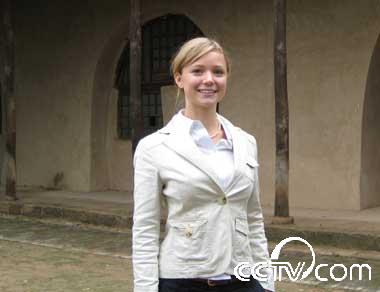Source: CCTV.com
01-25-2008 16:56
My adventure to Yan’an began as I arrived at the airport in Beijing. I was carted out to a very small airplane, just large enough to semi-comfortably fit eight passengers. It felt as if we were just going to land on a patch of farmland that spanned every inch of the horizon as we approached for landing, as there was no airport in sight. That didn’t happen. Our mini-plane had arrived at a mini-airport. There were no gates, escalators or even stairs for that matter. It was a single-lane runway next to a single-storey whitewashed building with one ticketing counter inside. Baggage claim was the flatbed of a pickup truck.
 |
Yan’an is a revolutionary hotspot in Chinese history, the resting place after the Long March, where Mao Zedong started to lead the people, where volumes of Communist manifestos had been written. In other words, one bright word can be used to describe the city: Red. Our crew was on a mission to find out how this revolutionary spirit had transformed the city and its residents, and to discover how foreign visitors of the time perceived this so-called utopia.
I had read about Yan’an before, and the images that stuck in my mind were of dusty yellow earth and terraced farming plots. I was shocked to see nothing but greenery. I inquired with our driver about what happened to the dirt, and he said “times have changed.” In 1999, sets of policies were enacted that would basically give the terraced plots back to nature. It was an effort to cut down on soil erosion and decrease the intensity of sandstorms which regularly sweep through the country. In just eight years, it had gone from looking like a Saharan desert, or should I say the Gobi desert, to a lush green forest. This certainly was China changing. Even the topography was changing. At that moment in time, I felt so lucky to be in Yan’an, to be in China, to be able to see and experience for myself all the transformations throughout the land.
One feature of Yanan that I must relay to anyone and everyone considering a visit to this wonderful place is the food. It is gastronomic heaven! The ingredients are all extremely fresh, and oil is used very sparingly – a feature that any foreigner in China quickly learns to appreciate! Dates are a common crop of the region: the best ones called “Dog Head Dates”. One mouth-watering specialty is steamed pumpkin topped with a few warmed dates. Mmm. One thing I was surprised to find so tasty was the mutton. I am usually not very carnivorous, but this pulled mutton spiced with anise and other curry-like dried herbs hit the spot every time. I think you get the picture at this point; the food itself is worth the trek out there.
There were many tourists in Yanan, but whether or not they came for the food, this I will never know. But I do know that they were all interested in Yanan’s history as the 1930s Communist base camp against the Japanese. Among the tourists were elderly who may have gone through those trying times, 20 and 30-somethings with a curiosity about the formation of their country, and energetic student field trips. The most popular sites were cave dwellings, where legendary leaders like Mao Zedong and Zhou Enlai used to live and govern. As a foreigner, the cave homes were a funny concept for me to wrap my mind around. Who ever heard of modern people living in caves? They were actually pits carved out of the sides of mountains! Standing in them actually reminded me of being in the basement of a typical US home. Dark, musty, and a feeling of being a bit cut off from activity outside.
